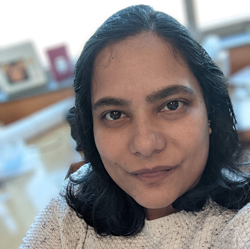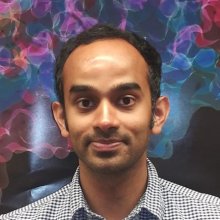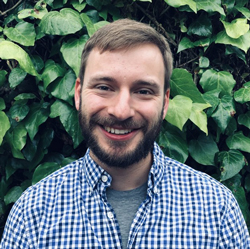Research in Biological Sciences
The faculty and students in the Department of Biological Sciences at University at Albany are actively engaged in research in highly diverse research topics and projects addressing a spectrum of issues of interest and concern to the scientific and general community.
Faculty in the Department of Biological Science work with graduate students in the Molecular, Cellular, Developmental, and Neural biology MS and Ph.D. programs and in the forensics MS program on diverse research projects spanning the mechanisms of cell signaling inside the nucleus and cytoplasm to connections between cells and with the extracellular environment in eukaryotic cells and involvement of prokaryotic organisms with disease.
Supervised undergraduate research provides students with the opportunity to gain practical experience working in actual research labs with respected faculty and the opportunity to gain experience in presenting their research and competing for awards.
Cheryl P. Andam
Research in our lab focuses on microbial genomics and evolution as they apply to infectious diseases and public health. We ask the question: Why aren’t members of a microbial species the same? They may be clonal, but microbial populations are often composed of multiple co-circulating lineages distinguished by large phenotypic and genetic differences. Understanding the origins of genomic variation between strains is fundamental to questions critical to society and public health, such as "Are emerging diseases new species, or variants of existing ones?", “What makes a resistant strain successful?”, and "How will a pathogen respond to selective pressures?". To explore these questions, we use whole genome sequencing of closely related strains to understand the evolutionary, ecological and epidemiological dynamics of bacterial pathogens, which will inform effective, more targeted public health interventions. Current work focuses on different species of bacterial pathogens (e.g., Staphylococcus, Streptococcus, Salmonella) and antibiotic- producers (e.g., Streptomyces). Students will be trained in population genomics, phylogenetics, molecular evolution, and genomic epidemiology.
Thomas (Tom) Begley
The Begley lab works on research projects that span the areas of environmental health, cancer and aging. We work to identify and characterize mechanisms of cellular stress response, with a special emphasis on reactive oxygen species detoxification and DNA repair. Specific areas of research are epitranscriptomic writers and targets, tRNA modification, and the translational regulation of protein networks. We use computational approaches, bacterial, yeast, human cell culture and mouse models in our research. We train students to utilize genetic, molecular biology and biochemical techniques to dissect the inner workings of cells and tissues, with the goal of identifying important responses to stress which are linked to human disease.
J. Andrew (Andy) Berglund
The primary goals of the Berglund lab are to understand the molecular mechanisms of pre-mRNA splicing and toxic RNA disorders including myotonic dystrophy and C9orf72 amyotrophic lateral sclerosis. We use biochemical, genomic and cellular approaches to study the fundamental rules that govern RNA processing and how these events are disrupted in disease. Knowledge gained from basic biological studies is applied to developing small molecule therapeutic strategies for these devastating neuromuscular diseases.
Haijun Chen
Our research areas are focused on molecular and cellular physiology. With combinations of conventional electrophysiology, biochemistry, molecular biology, and engineering techniques, we study mechanisms of how ion channels contribute to cellular function and are associated with cardiovascular, neuronal, and skeletal muscle diseases. Current research projects include: 1) Engineer a cell line that shows pacemaker activity and mimics cardiac and neuronal pacemaker cells; 2) Molecular mechanisms of origin of pacemaker activity (or heart beat); and 3) Roles of a group of ion channels in pacemaker activity (or heart beat) and biological clock (or circadian rhythm).
Soma Dash

Research in the Dash Lab is focused on craniofacial development, which begins early during embryogenesis with the formation of neural crest cells. Neural crest cells are a transient population of cells that are derived in the dorsal region of the neural tube, undergo an epithelial to mesenchymal transition, migrate to various parts of the body where they interact with their surrounding tissue to undergo terminal differentiation to make up most of the craniofacial bone and cartilage as well as neurons and glia of the peripheral nervous system and melanocytes. Any defects in neural crest formation, migration or differentiation leads to developmental defects known as neurocristopathies, which often involve craniofacial anomalies. When certain subunits of the Mediator complex, which is required for transcription of all mRNA by RNA Polymerase II, are mutated, it leads to defects in neural crest cell and craniofacial development in mice and zebrafish. Our research aims to understand how and why the absence of such ubiquitously expressed genes/proteins results in tissue-specific craniofacial defects.
Bijan Dey (Adjunct)
The focus of my laboratory is to explore the function of non-coding RNAs (microRNAs and novel small/long non-coding RNAs), epigenetics and epitranscriptomics in skeletal muscle stem cell biology, cardiac muscle biology, muscle regeneration, and muscle degenerative disease including Duchenne Muscular Dystrophy (DMD) and DMD-associated cardiomyopathy. DMD is a devastating X-linked childhood muscle degenerative disease. There is no effective treatment available that can either cure or stop the progression of DMD. The development of a successful therapy for DMD has been significantly hindered due to the lack of a complete understanding of the key myogenic processes and DMD pathophysiology at the molecular level. Our goal is to understand the fundamental molecular mechanism of muscle development and to devise new therapeutic and diagnostic platforms for DMD and related muscle degenerative diseases.
Paolo Forni
In my lab we study neurodevelopment. The focus of my research is to discover new molecular mechanisms underlying cell differentiation migration of neurons and to discover molecular principles defining neuronal identity, synaptic selectivity and neuronal circuit formation in mammals. For this we use a multidisciplinary approach that includes the generation and use of complex genetically-modified mouse models, state of the art 2D and 3D imaging, molecular biology next generation sequencing, bioinformatics, behavioral testing, and whole exome sequencing data of human patients. We have multiple national and international collaborations. Research projects in my lab received extensive federal funding.
Gabriele (Gaby) Fuchs
The Fuchs lab studies the mechanism and regulation of protein biosynthesis in mammalian cells. Proteins are made by large cellular RNA-protein complexes known as ribosomes, which translate the mRNA sequence into a protein sequence. Until recently it was thought that all ribosomes within one organism were identical. However, mass spectrometry analysis revealed that ribosomes differ in composition and posttranslational modifications. Although many ribosome modifications have been identified, the impact these modifications have on protein biosynthesis is not clear. Using a combination of approaches, we are investigating different mechanisms of translation initiation and the role ribosome composition plays during translation.
Melinda (Mindy) Larsen
The Larsen lab focuses on understanding biological mechanisms driving development, organ repair, and regeneration. Cells residing in the stroma provide signals that drive development and maintain homeostasis in the adult but alteration of signals leads to disease and loss of gland function. We are interested in defining stromal signals that drive development and that can be manipulated to facilitate gland regeneration and restoration of function. We use salivary gland organoids and in vivo models to examine cell-cell and molecular interactions driving development and disease.
ChangHwan Lee
The Lee lab studies cell-to-cell communications in health and disease. We develop and use quantitative methods to understand how cell-cell signaling pathways regulate tissue integrity during development, homeostasis and disease. Our current research focus centers on Notch signaling and its transcriptional regulation in stem cells. Notch signaling is a broadly conserved pathway critical for metazoan development, with Notch dysfunction leading to various human diseases, including cancer and cardiovascular disease. However, remarkably little is known about how Notch defects affect signaling at the molecular level to cause such diseases. Understanding precise molecular mechanisms of disease-causing Notch defects have potential to lead to discovery of novel therapies. We use
a multidisciplinary approach, combining biochemistry, cell biology, genetics, statistics and computational biology to understand how Notch signaling drives its transcriptional response in space and time, quantitatively and with single- molecule precision. We also aim to analyze the Notch response in disease-causing Notch states and investigate the effect of environmental, physiological, and pathological conditions on the Notch response. Our multidisciplinary, single- molecule approach put our lab in a unique vantage point to bring novel insights into quantitative understanding of cell signaling in an in vivo context.
Pan T.X. Li
Single molecule study of RNA folding and protein-RNA interaction. Goal: Our goal is to understand the fundamental principles that governing the folding of RNA and to protein-RNA interactions. Overview: Folding of an RNA molecule can be viewed as a biased diffusion over its folding energy landscape. Such landscape is populated with different energetic states, similar to “hills” and “valleys” on a geographic map. We survey the folding energy landscape by following folding trajectories of individual molecule. Relative levels of energetic states are reflected by folding rates as high energy barrier slows folding. Also, a molecule is more likely to take an “easy” route to fold than to follow a “difficult” one. We are particularly interested in three areas. (1) Force induced misfolding; (2) Formation of RNA kissing complexes, a type of tertiary structures formed between loops of two hairpins; (3) Ligand and protein binding to RNA structures. Approach: We use a device called optical tweezers to apply pico-Newton (10-12 Newton) force to single RNA molecules. As an RNA molecule folds and unfolds, changes in the extension of the molecule, measured with nanometer precision, reflect structural transitions in real time. Parallelly, we use biochemical and spectroscopic methods to study RNA folding at ensemble. We also employ statistical mechanical modeling to interpret experimental results both in-house and through collaboration.
Cara Pager
The Pager lab is interested in how RNA viruses subvert different cellular RNA metabolism pathways. In our lab we study hepatitis C virus (HCV), Zika virus and Dengue virus. These are single-stranded positive-sense RNA viruses that are associated with devastating human diseases such as hepatocellular carcinoma, intense joint and muscle pain and developmental defects in new-born babies. To date there are no licensed antivirals or a vaccine. In the Pager lab applies virology, RNA biology, molecular biology, cell biology and biophysical approaches together with mass spectrometry and next generation sequencing technologies to understand the fundamental molecular biology of these viruses. In particular we are investigating the interaction and molecular mechanisms by which these RNA viruses subvert the host splicing machinery, RNA storage and decay pathways and the epitranscriptome. Additionally, we are investigating RNA structures and RNA-RNA interactions within the viral genomes to understand how these viruses regulate distinct steps in their infectious cycles. By understanding virus-host interactions our research may lead to the identification of new antiviral targets and therapies.
Kaalak Reddy (Adjunct)

The Reddy Lab is interested in how RNA dysfunction can play a role in neuromuscular diseases and are leveraging this knowledge to develop new therapeutic strategies. We are specifically investigating RNA dysregulation in myotonic dystrophy and in human ITPase enzyme deficiency using a combination of biochemical, cellular and genomic approaches.
Morgan Sammons
We are interested in understanding how DNA information is decoded by a class of proteins called transcription factors. DNA is the instruction manual for building an organism and maintaining its homeostasis. We are most interested in how cells decode this information during life or death situations, such as when cells encounter rapidly changing environmental signals. Projects in the lab will focus on using genomics, molecular biology, and high-throughput approaches to study how transcription factors interpret genetic and epigenetic information to control cell survival after exposure to DNA damage.
Annalisa Scimemi
In our lab, we are interested in understanding the functional properties of central synapses, the specialized structures that convert the electrical activity of a neuron into a chemical signal for its target cells. We want to understand how individual molecules are distributed within the synapse and how their spatial arrangement influences the properties of neurotransmitter release. We want to know how neurotransmitters diffuse outside of the synapse and generate long-distance signals to different cells. Our ultimate goal is to gain insights into the functional consequences of changes in synaptic function caused by changes in the circadian timekeeping system and with the onset of different neuropsychiatric and neurodenegerative disorders. To perform our studies, we use a combination of experimental and theoretical approaches, including electrophysiology, optogenetics, two-photon imaging and reaction- diffusion computer simulations. We are eager to learn and develop novel experimental approaches and research tools!
Hannah Shorrock
The Shorrock research group focuses on investigating RNA mediated mechanisms of disease pathogenesis and how these mechanisms can be targeted for therapeutic intervention in rare neurodegenerative diseases. In particular, the lab focuses on a group of spinocerebellar ataxia subtypes caused by inherited CAG repeat expansions to investigate the potential for shared therapeutics across this group of diseases. With a focus on repurposing and development of novel small molecule therapeutics, our research group uses a range of disease models from engineered screening cell lines to patient derived fibroblast cell lines, patient derived induced pluripotent stem cells and mouse models to assess therapeutic efficacy and mechanisms of action.
Alongside our therapeutic focused work, we study the contribution of alternative splicing and RNA structure to disease processes and pathogenesis across multiple spinocerebellar ataxias and more broadly across neurodegenerative and neurological conditions. Understanding more about disease mechanisms and processes can help to identify novel cellular targets for development of therapeutic approaches and establish readouts for assessing therapeutic efficacy.
Max Turner

Work in our lab is centered on understanding how the brain processes visual information. We are especially interested in this question in the context of natural vision. The kinds of visual inputs encountered in the real world can be enormously complex. This poses a real challenge to nervous systems, which are tasked with extracting and representing useful information about the scene in order to guide behavior. We leverage the compact and genetically accessible fruit fly brain as a model to understand how neural circuits overcome this challenge. We use a combination of experimental and computational approaches, including in vivo two photon imaging, animal behavior, analysis of the connectome, and advanced image analysis approaches, to concretely link specific neurons, circuits and synapses to neural computations and, ultimately, to visually guided behavior. A fly’s visual system is in many respects quite different from our own, but there are powerful constraints that are shared across very different species, from flies to humans. For example, the same physical laws that underlie the statistics of scenes encountered by flies also shape the scenes humans encounter. These statistical regularities can constrain neural processing strategies. This allows us to use the fly visual system to learn general principles of natural vision that apply across species.
Alex Valm
My laboratory is interested in the relationship between structure and function in the human microbiome; especially how the physical structure of human associated-microbial communities influence health and disease. We use the human oral microbiome as a model system for studying microbial community structure and assembly because it is well-studied and accessible. We combine molecular and DNA sequencing approaches to understand what organisms, genes and potential functions are present in a community and we use advanced imaging technologies to map the spatial distribution of organisms within their environments. With our collaborators in the Biology department as well as outside the UAlbany community we study the systems level spatial structure of oral microbial biofilms in animal models and humans. We combine this discovery based research with hypothesis testing using in vitro culture systems. A second major focus of the lab is to further develop imaging technologies to expand the number of identifiable objects in a microbial sample as well as the development of computational tools for analysis of community structure.
Visit the PhD in Biology program page for more information
Visit the MS in Biology program page for more information
Centers and Institutes
Graduate research benefits from the department’s access to state-of-the-art research facilities, including Biological Imaging facilities as well as resources available at the RNA Institute and the Core facilities (including the Tissue Culture Core, Molecular Core, Chemistry Core, Mass Spectrometry Core, Animal Labs, and Nuclear Magnetic Resonance Imaging facility).
The designation of Center, Institute, Facility, Laboratory, and Initiative denote organizational units or processes that foster collaborations.
The collaboration can involve different academic departments, different schools and colleges and even on- and off-campus investigators. Although often focusing on a particular area of research, they can also focus on teaching. The Department of Biological Sciences is involved in several such collaborations.
- Center for Achievement, Retention and Student Success
- Center for Excellence in Cancer Genomics
- Center for Neuroscience Research
- Life Sciences Research Initiative
- The RNA Institute


